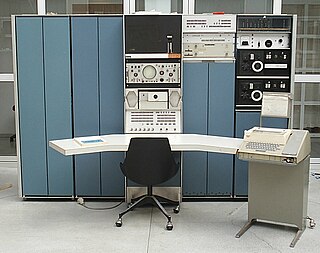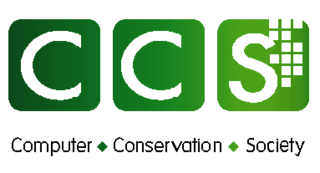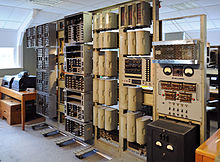
The history of computing hardware covers the developments from early simple devices to aid calculation to modern day computers.

The PDP-7 is an 18-bit minicomputer produced by Digital Equipment Corporation as part of the PDP series. Introduced in 1964, shipped since 1965, it was the first to use their Flip-Chip technology. With a cost of US$72,000, it was cheap but powerful by the standards of the time. The PDP-7 is the third of Digital's 18-bit machines, with essentially the same instruction set architecture as the PDP-4 and the PDP-9.

The Black Country Living Museum is an open-air museum of rebuilt historic buildings in Dudley, West Midlands, England. It is located in the centre of the Black Country, 10 miles west of Birmingham. The museum occupies 10.5 hectares of former industrial land partly reclaimed from a former railway goods yard, disused lime kilns, canal arm and former coal pits.

The University of Wolverhampton is a public university located on four campuses across the West Midlands, Shropshire and Staffordshire in England. The roots of the university lie in the Wolverhampton Tradesmen's and Mechanics' Institute founded in 1827 and the 19th-century growth of the Wolverhampton Free Library (1870), which developed technical, scientific, commercial and general classes. This merged in 1969 with the Municipal School of Art, originally founded in 1851, to form the Wolverhampton Polytechnic.

The Computer Conservation Society (CCS) is a British organisation, founded in 1989. It is under the joint umbrella of the British Computer Society (BCS), the London Science Museum and the Manchester Museum of Science and Industry.
A witch is a practitioner of witchcraft.

Pixelh8 is the stage name for Matthew Applegate, a British chiptune composer, educator and screen actor.

The Atlas Computer Laboratory on the Harwell, Oxfordshire campus shared by the Harwell Laboratory was one of the major computer laboratories in the world, which operated between 1961 and 1975 to provide a service to British scientists at a time when powerful computers were not usually available. The main user population was the UK universities and some government agencies.

In electronics, a Dekatron is a gas-filled decade counting tube. Dekatrons were used in computers, calculators, and other counting-related products during the 1950s and 1960s. "Dekatron" was the brand name used by Ericsson Telephones Limited (ETL), of Beeston, Nottingham and has since become a generic trademark. The device was invented by John Reginald Acton, with the patent assigned to Ericsson.

A transistor computer, now often called a second-generation computer, is a computer which uses discrete transistors instead of vacuum tubes. The first generation of electronic computers used vacuum tubes, which generated large amounts of heat, were bulky and unreliable. A second-generation computer, through the late 1950s and 1960s featured circuit boards filled with individual transistors and magnetic-core memory. These machines remained the mainstream design into the late 1960s, when integrated circuits started appearing and led to the third-generation computer.

The National Museum of Computing is a museum in the United Kingdom dedicated to collecting and restoring historic computer systems. The museum is based in rented premises at Bletchley Park in Milton Keynes, Buckinghamshire and opened in 2007. The building — Block H — was the first purpose-built computer centre in the world, hosting six Colossus computers by the end of World War II.

Anthony Edgar "Tony" Sale, FBCS was a British electronic engineer, computer programmer, computer hardware engineer, and historian of computing. He led the construction of a fully functional Mark 2 Colossus computer between 1993 and 2008. The rebuild is exhibited at The National Museum of Computing at Bletchley Park in England.

Robert Howlett was a British pioneering photographer whose pictures are widely exhibited in major galleries. Howlett produced portraits of Crimean War heroes, genre scenes and landscapes. His photographs include the iconic picture of Isambard Kingdom Brunel which was part of a commission by the London-based weekly newspaper Illustrated Times to document the construction of the world's largest steamship, the SS Great Eastern.

The Centre for Computing History is a museum in Cambridge, England, established to create a permanent public exhibition telling the story of the Information Age.

The Harwell CADET was the first fully transistorised computer in Europe, and may have been the first fully transistorised computer in the world.
Jack Howlett CBE was a British mathematician and computer scientist who was head of the Atlas Computer Laboratory for the duration of its existence.

Dina St Johnston was a British computer programmer credited with founding the UK's first software house in 1959.
Edmund Harry Cooke-Yarborough was the lead designer of the Harwell Dekatron, one of the world's early electronic computers and also a pioneer of radar.
John David Yeadon is a British artist and art educator. A practicing artist for over 50 years, he explored issues of politics, sexuality, food, national identity, the grotesque and carnival. In the 1980s, his work was provocative with issues relating to male sexuality. An eclectic artist, essentially a painter and printmaker, his work has included text, digital images, and photography, and he has worked on banner making, theatre design and has collaborated with video artists.
The Retro Computer Museum (RCM) is a museum in Leicester, England dedicated to the benefit of the public for the preservation, display, and public experience of computer and console systems from the 1960s onwards.
















